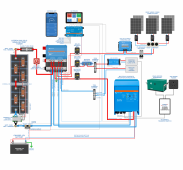childcarepro
New Member
- Joined
- Jul 5, 2020
- Messages
- 101
Hey @Boondock Saint, thanks for taking the time. I mean it!Hey I'm fine w it too, that was my original answer. HOWEVER at 3 in the morning I then saw a post by an admin saying otherwise so I did some rethinking and big long edit. I want my sleep back now!
What is this, rev 3 of your drawing I've downloaded? If I can ever finally get a system designed I'm gonna plagiarize the hell out of it. : D
This is like rev 13. I keep tinkering until it's finally built. So if I want to get any sleep, I'll have to have this thing done soon!
Feel free to plagiarize. If you want the original file, I'll be happy to share. I had to make a lot of original drawings, including the Overkill 8S BMS, the busbars, the class T fuse holder, the mini fuse holders, the circuit breakers, the shore power plug... I'll be happy if someone else can benefit from my work.




